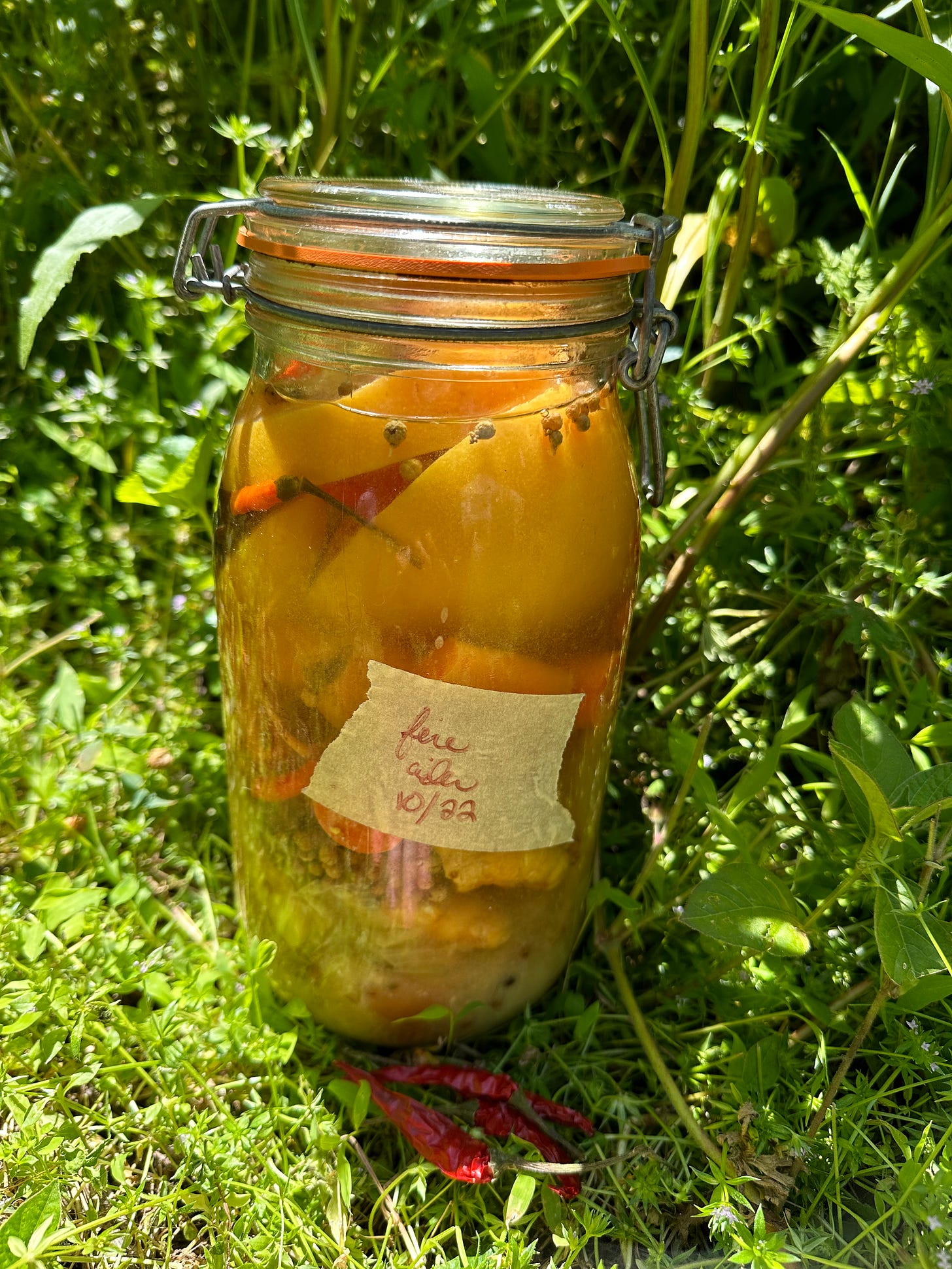This is the free version of my newsletter. If you want to support my writing (and receive free workshops and other resources as a thank you), please consider a paid subscription for yourself or a gift subscription for a friend.
You can also support my work on Patreon, starting at $1/month.
If you can't afford the paid newsletter, but it would be an asset to you in your own culinary/writing/creative journey, please reach out and we'll figure something out!
I love fire cider. If you’ve known me for any length of time at all, you’ve probably tried my fire cider, heard me talk about fire cider, or watch me gift fire cider to someone (perhaps that someone was you).
I even use it as a means to repurpose food scraps and as a base for culturing butter (the method for that is in Our Fermented Lives, and in The Fermentation Oracle Deck).
Fire cider is, to me, a symbol of community healing and reciprocity: Among many of my friends, sharing fire cider with others is a beautiful ritual in showing care.
It’s also part of a long, global history of medicinal vinegars, something I wrote a bit about recently for Mother Earth News.
A harvest season community care ritual
Fire cider offers a simple ritual for honoring the shifting seasons. You can gather your ingredients and make your cider whenever you wish (though I try to do it on the new moon), let them steep for about 30 days and then, as the weather gets chillier and cold and flu season is in full force, you have a tonic at the ready to help keep you healthy.
It’s a great excuse to come together with friends, everyone bringing ingredients to contribute and together making jars for each person to take home.
Or, you can enjoy your fire cider-making ritual solo, crafting a jar for yourself and a jar to give to someone who needs it.
Making fire cider
Fire cider is endlessly adaptable and customizable, and I adapted my method for both books (I’ll be creating a third version, too, for The Essential Preserving Handbook).
I make a low-waste version using scraps from elsewhere in my cooking practice, the method for which I plan to share in some version at some point soon.
Fire cider from Our Fermented Lives
Fire cider relies on unpasteurized vinegar and is typically made with apple cider vinegar. It also commonly emphasizes hot peppers and alliums (onion and garlic). Aside from that, the ingredients are extremely flexible and vary from person to person and even batch to batch. This is a great way to use up little bits of vegetable matter (like onion tops) or herb stems from other cooking projects! The goal is to get as much goodness packed into the jar as possible.
I classify my ingredients into three main groups—roots, shoots and fruits, and spice—and mix and match between them.
Fire cider can be enjoyed as a daily tonic by the shot glass or spoonful, or it can be incorporated into recipes, dressings, and marinades in place of apple cider vinegar. You can also use it to culture butter, as in the recipe on page 6 [of Our Fermented Lives].
ROOTS
Onion, garlic, turmeric, ginger, horseradish, carrot, et cetera
SHOOTS AND FRUITS
Citrus peel, thyme, rosemary, parsley, wild greens, dried cherries or elderberries, et cetera
SPICE
Hot peppers (any variety), cinnamon sticks, star anise, cloves, et cetera
CIDER
Unpasteurized apple cider vinegar Honey (optional)
Slice, cube, or coarsely chop the roots, and cut the hot peppers in halves or quarters.
Pack all of the roots, shoots and fruits, and spices tightly into a pint jar, and fill all the way to the neck with the vinegar, making sure everything is submerged. Cover with a tightly fitting lid.
Let steep at room temperature for at least 1 month. If bits of herbs and spices float to the top, gently shake the jar each day to redistribute them.
Once it’s ready, strain the aromatics from it. If you want to add honey, stir it in now. Bottle the finished fire cider and store at room temperature; it will keep indefinitely.
In my next book I offer various customizations based on this same method. These include seasonal fire ciders (spring and summer versions heavy on berries or on spring greens, for example), a spiced fall cider heavy with the cinnamon and clove, and ginger and citrus (and great with honey) but light on any garlic and onion, and a five spice cider that relies on one of my favorite flavor profiles.
Taking fire cider
Fire cider can be taken by the spoonful in the morning, or added to your favorite dishes (think marinades, dressings, stirred in soups). I’ve even added it to bloody Marys before.
If your fire cider is too zesty for your liking, consider stirring in a bit of honey to mellow it out.
Spread the community care forward: Why not share this post with a friend?
Supporting this newsletter literally makes my dreams come true, helping me devote my time to writing and to sending more and better recipes, interviews, and food stories to you. Thank you for being a part of my work!




I love fire cider too—mostly because it makes me believe I can summon the ghost of Julia Child, and join an indie folk band that performs in barn weddings. I can start with the belief and see where it takes me...
I added a whole cut up lemon and cut up orange, not just the rinds, if this going to cause my fire cider to go bad quicker?